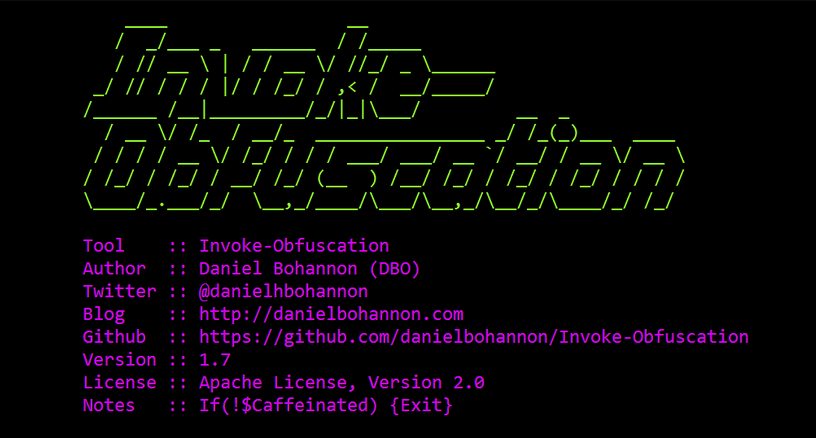PowerShell
PowerShell malware is commonly a dropper or downloader for the actual payload which means they are often rather at the beginning of the infection chain.
Because PowerShell runs on the .NET Common Language Runtime, it is easy to dynamically load and execute .NET assemblies via PowerShell, making this a common target of PowerShell malware.
Malicious Windows Shortcut (LNK) files and Batch files may be used to call PowerShell code, which is why obfuscation techniques related to Batch are often seen in conjunction with PowerShell commands.
Commands for PowerShell are also known as cmdlets. They are written in .NET or PowerShell.
Deobfuscation Basics
The following sections will help you to deobfuscate PowerShell samples.
Beautifier
Start with beautifying the code, e.g., via:🔗Powershell-Beautifier by DTW-DanWard
Command Help
Use the cmdlets Get-Help, Get-Command and Get-Member in a PowerShell terminal to read about unknown commands you find in a script.
Before you start, run Update-Help to download the latest help files.
To get help for a command, e.g., for Update-Help, execute
More on this topic: PowerShell 101 - The Help System
Inspect variables
To inspect variable contents, use:
'&' Instruction
The '&' is like a call instruction. General syntax:
& command [args]
Example:
& ($SomeObfusVar1) $SomeObfusVar2;
Replace this with an inspect statement like Write-Output or Write-Host
Obfuscation methods
This section lists common obfuscation that is specific for PowerShell.
Backticks `
Backticks are used for escaping characters in PowerShell and wrapping lines of code. It’s commonly used to escape non-special characters and break-up words to prevent pattern matching.
Carets \^
Carets are escape characters for the Windows command line.
Empty Quotes ""
Empty quotes are used to break up variables in PowerShell.
Escaped Quotes \"
When dealing with layered PowerShell scripts, escaped empty quotes may be passed to substrings.
Concatenation
This is not an effective obfuscation against reversers but it works against pattern matching.
New-Object $("Sys"+"tem.Refl"+"ection.Ass"+"embl"+"yName")
New-Object $("System.Reflection.AssemblyName")
Obfuscators
The following obfuscators and obfuscation frameworks are commonly used to during the creation of PowerShell malware. You can play around with them and see how their output looks like.
Invoke-Obfuscation
Invoke-PSObfuscation
Resources
🔗PowerShell 101: The No-Nonsense Beginner's Guide to PowerShell
This is a leanpup book by Mike F. Robbins.
The developer of Invoke-PSObfuscation describes PowerShell obfuscation techniques with specific code snippets in this blog article.
You will find the very same code snippets in slight variations throughout PowerShell malware. So getting familiar with them will help to speed up analysis.
🔗Practical Behavioral Profiling of PowerShell Scripts through Static Analysis (Part 2)
The section Normalization / Obfuscation Removal provides an overview on common obfuscation techniques.
🔗DOSfuscation: Exploring the Depths of Cmd.exe Obfuscation and Detection Techniques
This is a paper by FireEye on Batch obfuscation techniques. FireEye probably established the term DOSfuscation. While this is not actually describing PowerShell obfuscation, DOSfuscation is commonly seen in conjunction with PowerShell code because malware often calls PowerShell.exe via cmd.exe.


